Corporate Finance: Capital Structure and Investment Analysis
VerifiedAdded on 2020/06/06
|7
|1694
|83
Report
AI Summary
This report delves into the core aspects of corporate finance, focusing on capital structure, investment valuation, and tax implications. The analysis begins with an exploration of capital generation through debt and equity, discussing the advantages and disadvantages of each, including the impact of financial leverage on equity holder returns and the factors influencing debt levels. The report examines the measurement of market values for both levered and unlevered firms, calculates investment values, and analyzes arbitrage opportunities. Furthermore, it discusses the assumptions of Modigliani and Miller regarding capital structure and tax rates, calculating the cost of equity and the weighted average cost of capital (WACC). The report concludes by highlighting the importance of strategic financial decisions for corporate success and investment returns.
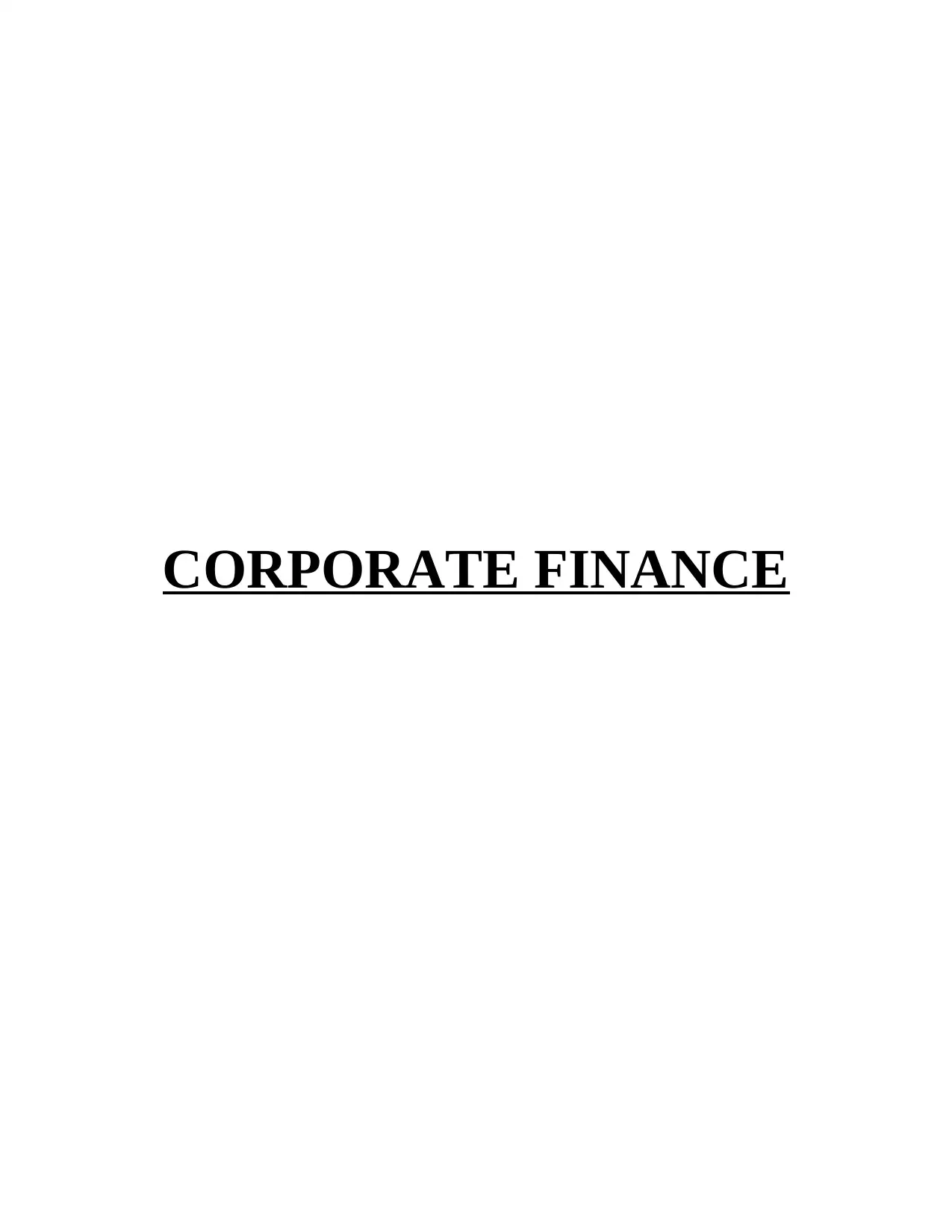
CORPORATE FINANCE
Paraphrase This Document
Need a fresh take? Get an instant paraphrase of this document with our AI Paraphraser
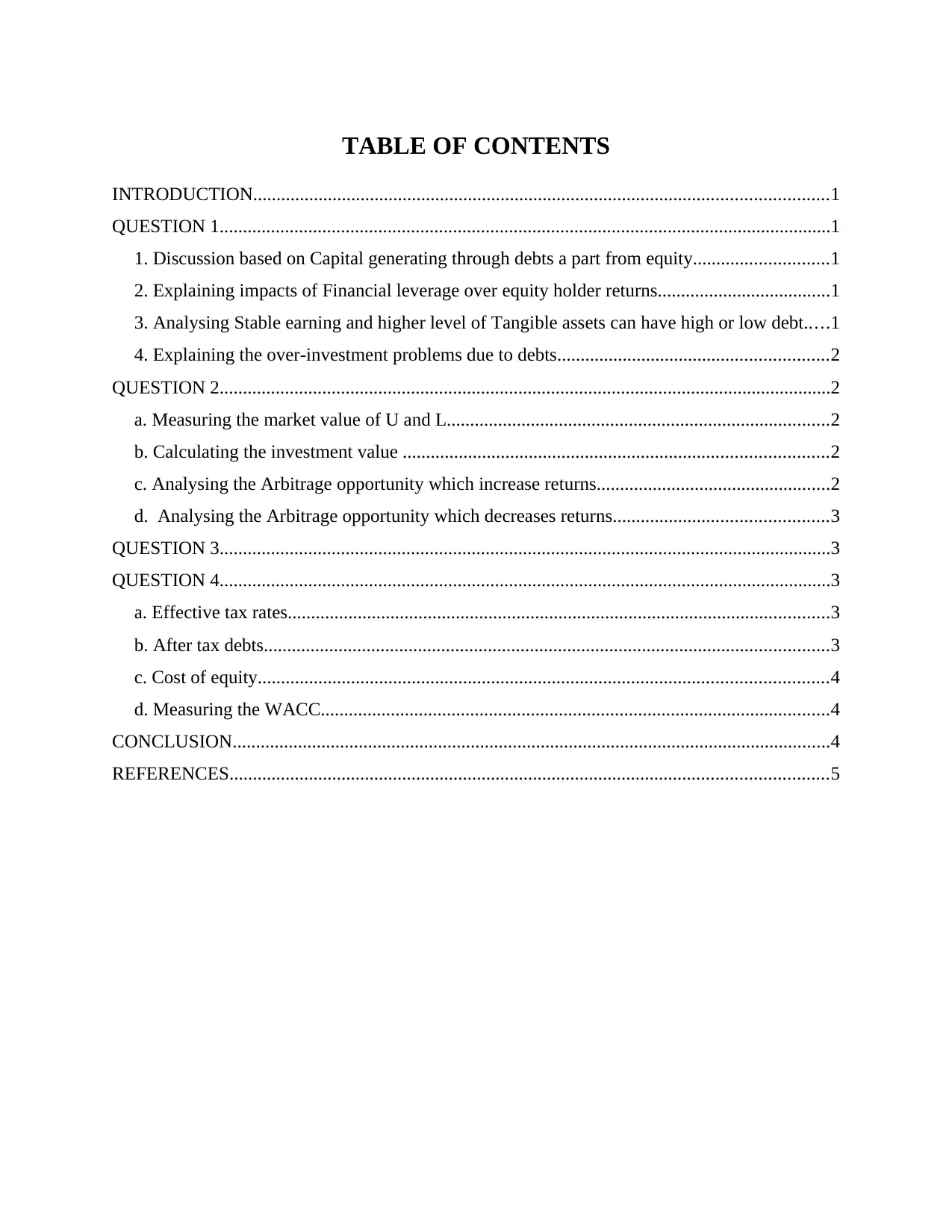
TABLE OF CONTENTS
INTRODUCTION...........................................................................................................................1
QUESTION 1...................................................................................................................................1
1. Discussion based on Capital generating through debts a part from equity.............................1
2. Explaining impacts of Financial leverage over equity holder returns.....................................1
3. Analysing Stable earning and higher level of Tangible assets can have high or low debt.....1
4. Explaining the over-investment problems due to debts..........................................................2
QUESTION 2...................................................................................................................................2
a. Measuring the market value of U and L..................................................................................2
b. Calculating the investment value ...........................................................................................2
c. Analysing the Arbitrage opportunity which increase returns..................................................2
d. Analysing the Arbitrage opportunity which decreases returns..............................................3
QUESTION 3...................................................................................................................................3
QUESTION 4...................................................................................................................................3
a. Effective tax rates....................................................................................................................3
b. After tax debts.........................................................................................................................3
c. Cost of equity..........................................................................................................................4
d. Measuring the WACC.............................................................................................................4
CONCLUSION................................................................................................................................4
REFERENCES................................................................................................................................5
INTRODUCTION...........................................................................................................................1
QUESTION 1...................................................................................................................................1
1. Discussion based on Capital generating through debts a part from equity.............................1
2. Explaining impacts of Financial leverage over equity holder returns.....................................1
3. Analysing Stable earning and higher level of Tangible assets can have high or low debt.....1
4. Explaining the over-investment problems due to debts..........................................................2
QUESTION 2...................................................................................................................................2
a. Measuring the market value of U and L..................................................................................2
b. Calculating the investment value ...........................................................................................2
c. Analysing the Arbitrage opportunity which increase returns..................................................2
d. Analysing the Arbitrage opportunity which decreases returns..............................................3
QUESTION 3...................................................................................................................................3
QUESTION 4...................................................................................................................................3
a. Effective tax rates....................................................................................................................3
b. After tax debts.........................................................................................................................3
c. Cost of equity..........................................................................................................................4
d. Measuring the WACC.............................................................................................................4
CONCLUSION................................................................................................................................4
REFERENCES................................................................................................................................5
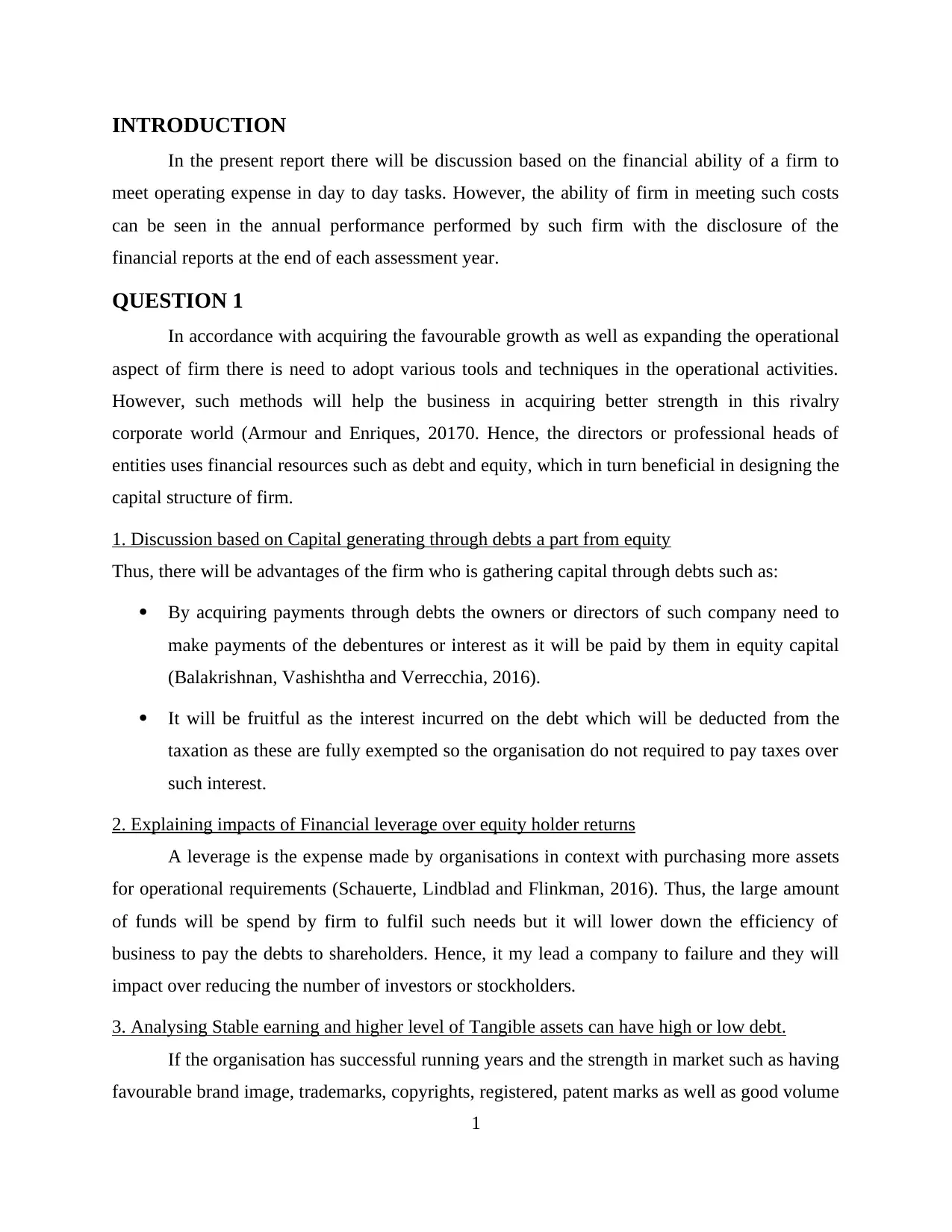
INTRODUCTION
In the present report there will be discussion based on the financial ability of a firm to
meet operating expense in day to day tasks. However, the ability of firm in meeting such costs
can be seen in the annual performance performed by such firm with the disclosure of the
financial reports at the end of each assessment year.
QUESTION 1
In accordance with acquiring the favourable growth as well as expanding the operational
aspect of firm there is need to adopt various tools and techniques in the operational activities.
However, such methods will help the business in acquiring better strength in this rivalry
corporate world (Armour and Enriques, 20170. Hence, the directors or professional heads of
entities uses financial resources such as debt and equity, which in turn beneficial in designing the
capital structure of firm.
1. Discussion based on Capital generating through debts a part from equity
Thus, there will be advantages of the firm who is gathering capital through debts such as:
By acquiring payments through debts the owners or directors of such company need to
make payments of the debentures or interest as it will be paid by them in equity capital
(Balakrishnan, Vashishtha and Verrecchia, 2016).
It will be fruitful as the interest incurred on the debt which will be deducted from the
taxation as these are fully exempted so the organisation do not required to pay taxes over
such interest.
2. Explaining impacts of Financial leverage over equity holder returns
A leverage is the expense made by organisations in context with purchasing more assets
for operational requirements (Schauerte, Lindblad and Flinkman, 2016). Thus, the large amount
of funds will be spend by firm to fulfil such needs but it will lower down the efficiency of
business to pay the debts to shareholders. Hence, it my lead a company to failure and they will
impact over reducing the number of investors or stockholders.
3. Analysing Stable earning and higher level of Tangible assets can have high or low debt.
If the organisation has successful running years and the strength in market such as having
favourable brand image, trademarks, copyrights, registered, patent marks as well as good volume
1
In the present report there will be discussion based on the financial ability of a firm to
meet operating expense in day to day tasks. However, the ability of firm in meeting such costs
can be seen in the annual performance performed by such firm with the disclosure of the
financial reports at the end of each assessment year.
QUESTION 1
In accordance with acquiring the favourable growth as well as expanding the operational
aspect of firm there is need to adopt various tools and techniques in the operational activities.
However, such methods will help the business in acquiring better strength in this rivalry
corporate world (Armour and Enriques, 20170. Hence, the directors or professional heads of
entities uses financial resources such as debt and equity, which in turn beneficial in designing the
capital structure of firm.
1. Discussion based on Capital generating through debts a part from equity
Thus, there will be advantages of the firm who is gathering capital through debts such as:
By acquiring payments through debts the owners or directors of such company need to
make payments of the debentures or interest as it will be paid by them in equity capital
(Balakrishnan, Vashishtha and Verrecchia, 2016).
It will be fruitful as the interest incurred on the debt which will be deducted from the
taxation as these are fully exempted so the organisation do not required to pay taxes over
such interest.
2. Explaining impacts of Financial leverage over equity holder returns
A leverage is the expense made by organisations in context with purchasing more assets
for operational requirements (Schauerte, Lindblad and Flinkman, 2016). Thus, the large amount
of funds will be spend by firm to fulfil such needs but it will lower down the efficiency of
business to pay the debts to shareholders. Hence, it my lead a company to failure and they will
impact over reducing the number of investors or stockholders.
3. Analysing Stable earning and higher level of Tangible assets can have high or low debt.
If the organisation has successful running years and the strength in market such as having
favourable brand image, trademarks, copyrights, registered, patent marks as well as good volume
1
⊘ This is a preview!⊘
Do you want full access?
Subscribe today to unlock all pages.

Trusted by 1+ million students worldwide
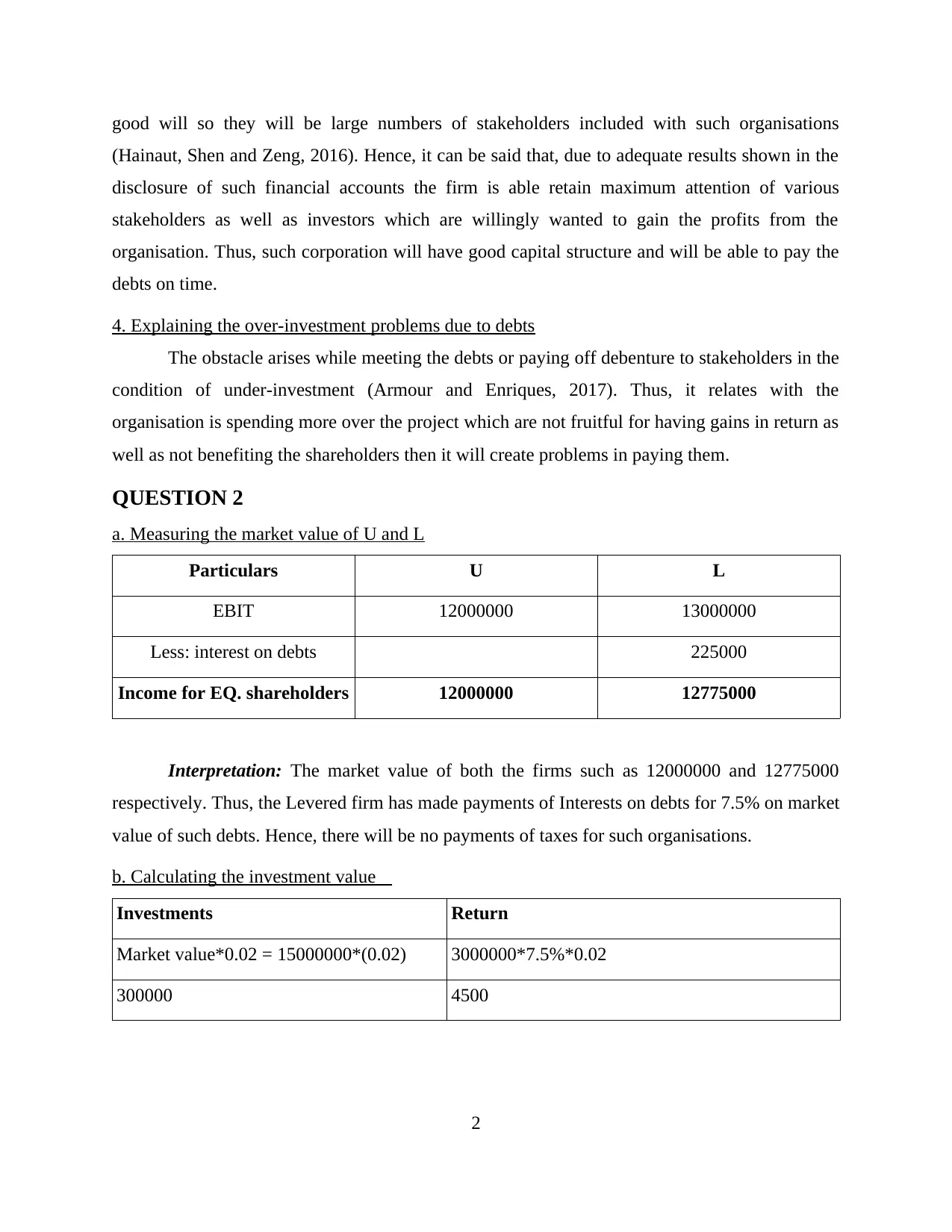
good will so they will be large numbers of stakeholders included with such organisations
(Hainaut, Shen and Zeng, 2016). Hence, it can be said that, due to adequate results shown in the
disclosure of such financial accounts the firm is able retain maximum attention of various
stakeholders as well as investors which are willingly wanted to gain the profits from the
organisation. Thus, such corporation will have good capital structure and will be able to pay the
debts on time.
4. Explaining the over-investment problems due to debts
The obstacle arises while meeting the debts or paying off debenture to stakeholders in the
condition of under-investment (Armour and Enriques, 2017). Thus, it relates with the
organisation is spending more over the project which are not fruitful for having gains in return as
well as not benefiting the shareholders then it will create problems in paying them.
QUESTION 2
a. Measuring the market value of U and L
Particulars U L
EBIT 12000000 13000000
Less: interest on debts 225000
Income for EQ. shareholders 12000000 12775000
Interpretation: The market value of both the firms such as 12000000 and 12775000
respectively. Thus, the Levered firm has made payments of Interests on debts for 7.5% on market
value of such debts. Hence, there will be no payments of taxes for such organisations.
b. Calculating the investment value
Investments Return
Market value*0.02 = 15000000*(0.02) 3000000*7.5%*0.02
300000 4500
2
(Hainaut, Shen and Zeng, 2016). Hence, it can be said that, due to adequate results shown in the
disclosure of such financial accounts the firm is able retain maximum attention of various
stakeholders as well as investors which are willingly wanted to gain the profits from the
organisation. Thus, such corporation will have good capital structure and will be able to pay the
debts on time.
4. Explaining the over-investment problems due to debts
The obstacle arises while meeting the debts or paying off debenture to stakeholders in the
condition of under-investment (Armour and Enriques, 2017). Thus, it relates with the
organisation is spending more over the project which are not fruitful for having gains in return as
well as not benefiting the shareholders then it will create problems in paying them.
QUESTION 2
a. Measuring the market value of U and L
Particulars U L
EBIT 12000000 13000000
Less: interest on debts 225000
Income for EQ. shareholders 12000000 12775000
Interpretation: The market value of both the firms such as 12000000 and 12775000
respectively. Thus, the Levered firm has made payments of Interests on debts for 7.5% on market
value of such debts. Hence, there will be no payments of taxes for such organisations.
b. Calculating the investment value
Investments Return
Market value*0.02 = 15000000*(0.02) 3000000*7.5%*0.02
300000 4500
2
Paraphrase This Document
Need a fresh take? Get an instant paraphrase of this document with our AI Paraphraser
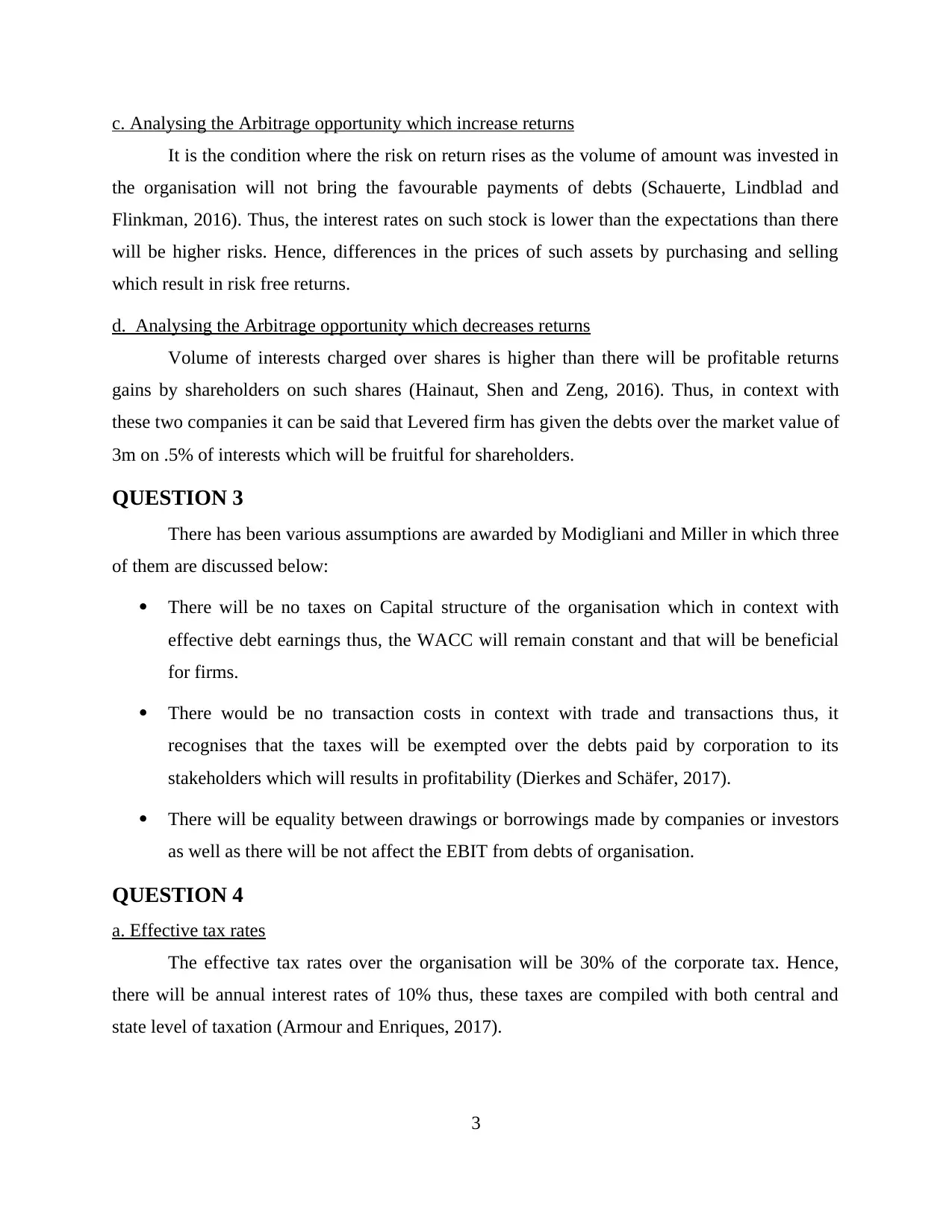
c. Analysing the Arbitrage opportunity which increase returns
It is the condition where the risk on return rises as the volume of amount was invested in
the organisation will not bring the favourable payments of debts (Schauerte, Lindblad and
Flinkman, 2016). Thus, the interest rates on such stock is lower than the expectations than there
will be higher risks. Hence, differences in the prices of such assets by purchasing and selling
which result in risk free returns.
d. Analysing the Arbitrage opportunity which decreases returns
Volume of interests charged over shares is higher than there will be profitable returns
gains by shareholders on such shares (Hainaut, Shen and Zeng, 2016). Thus, in context with
these two companies it can be said that Levered firm has given the debts over the market value of
3m on .5% of interests which will be fruitful for shareholders.
QUESTION 3
There has been various assumptions are awarded by Modigliani and Miller in which three
of them are discussed below:
There will be no taxes on Capital structure of the organisation which in context with
effective debt earnings thus, the WACC will remain constant and that will be beneficial
for firms.
There would be no transaction costs in context with trade and transactions thus, it
recognises that the taxes will be exempted over the debts paid by corporation to its
stakeholders which will results in profitability (Dierkes and Schäfer, 2017).
There will be equality between drawings or borrowings made by companies or investors
as well as there will be not affect the EBIT from debts of organisation.
QUESTION 4
a. Effective tax rates
The effective tax rates over the organisation will be 30% of the corporate tax. Hence,
there will be annual interest rates of 10% thus, these taxes are compiled with both central and
state level of taxation (Armour and Enriques, 2017).
3
It is the condition where the risk on return rises as the volume of amount was invested in
the organisation will not bring the favourable payments of debts (Schauerte, Lindblad and
Flinkman, 2016). Thus, the interest rates on such stock is lower than the expectations than there
will be higher risks. Hence, differences in the prices of such assets by purchasing and selling
which result in risk free returns.
d. Analysing the Arbitrage opportunity which decreases returns
Volume of interests charged over shares is higher than there will be profitable returns
gains by shareholders on such shares (Hainaut, Shen and Zeng, 2016). Thus, in context with
these two companies it can be said that Levered firm has given the debts over the market value of
3m on .5% of interests which will be fruitful for shareholders.
QUESTION 3
There has been various assumptions are awarded by Modigliani and Miller in which three
of them are discussed below:
There will be no taxes on Capital structure of the organisation which in context with
effective debt earnings thus, the WACC will remain constant and that will be beneficial
for firms.
There would be no transaction costs in context with trade and transactions thus, it
recognises that the taxes will be exempted over the debts paid by corporation to its
stakeholders which will results in profitability (Dierkes and Schäfer, 2017).
There will be equality between drawings or borrowings made by companies or investors
as well as there will be not affect the EBIT from debts of organisation.
QUESTION 4
a. Effective tax rates
The effective tax rates over the organisation will be 30% of the corporate tax. Hence,
there will be annual interest rates of 10% thus, these taxes are compiled with both central and
state level of taxation (Armour and Enriques, 2017).
3
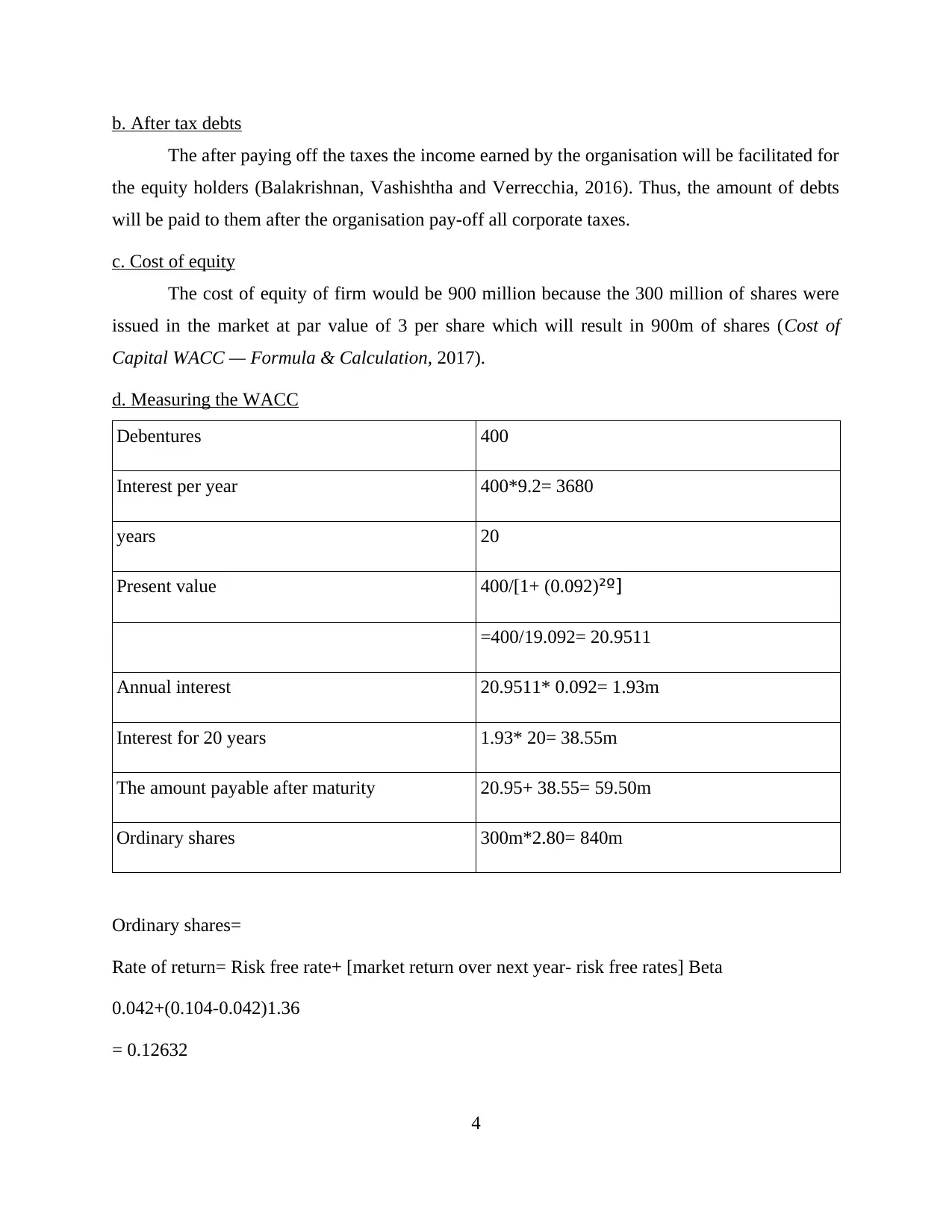
b. After tax debts
The after paying off the taxes the income earned by the organisation will be facilitated for
the equity holders (Balakrishnan, Vashishtha and Verrecchia, 2016). Thus, the amount of debts
will be paid to them after the organisation pay-off all corporate taxes.
c. Cost of equity
The cost of equity of firm would be 900 million because the 300 million of shares were
issued in the market at par value of 3 per share which will result in 900m of shares (Cost of
Capital WACC — Formula & Calculation, 2017).
d. Measuring the WACC
Debentures 400
Interest per year 400*9.2= 3680
years 20
Present value 400/[1+ (0.092)²º]
=400/19.092= 20.9511
Annual interest 20.9511* 0.092= 1.93m
Interest for 20 years 1.93* 20= 38.55m
The amount payable after maturity 20.95+ 38.55= 59.50m
Ordinary shares 300m*2.80= 840m
Ordinary shares=
Rate of return= Risk free rate+ [market return over next year- risk free rates] Beta
0.042+(0.104-0.042)1.36
= 0.12632
4
The after paying off the taxes the income earned by the organisation will be facilitated for
the equity holders (Balakrishnan, Vashishtha and Verrecchia, 2016). Thus, the amount of debts
will be paid to them after the organisation pay-off all corporate taxes.
c. Cost of equity
The cost of equity of firm would be 900 million because the 300 million of shares were
issued in the market at par value of 3 per share which will result in 900m of shares (Cost of
Capital WACC — Formula & Calculation, 2017).
d. Measuring the WACC
Debentures 400
Interest per year 400*9.2= 3680
years 20
Present value 400/[1+ (0.092)²º]
=400/19.092= 20.9511
Annual interest 20.9511* 0.092= 1.93m
Interest for 20 years 1.93* 20= 38.55m
The amount payable after maturity 20.95+ 38.55= 59.50m
Ordinary shares 300m*2.80= 840m
Ordinary shares=
Rate of return= Risk free rate+ [market return over next year- risk free rates] Beta
0.042+(0.104-0.042)1.36
= 0.12632
4
⊘ This is a preview!⊘
Do you want full access?
Subscribe today to unlock all pages.

Trusted by 1+ million students worldwide
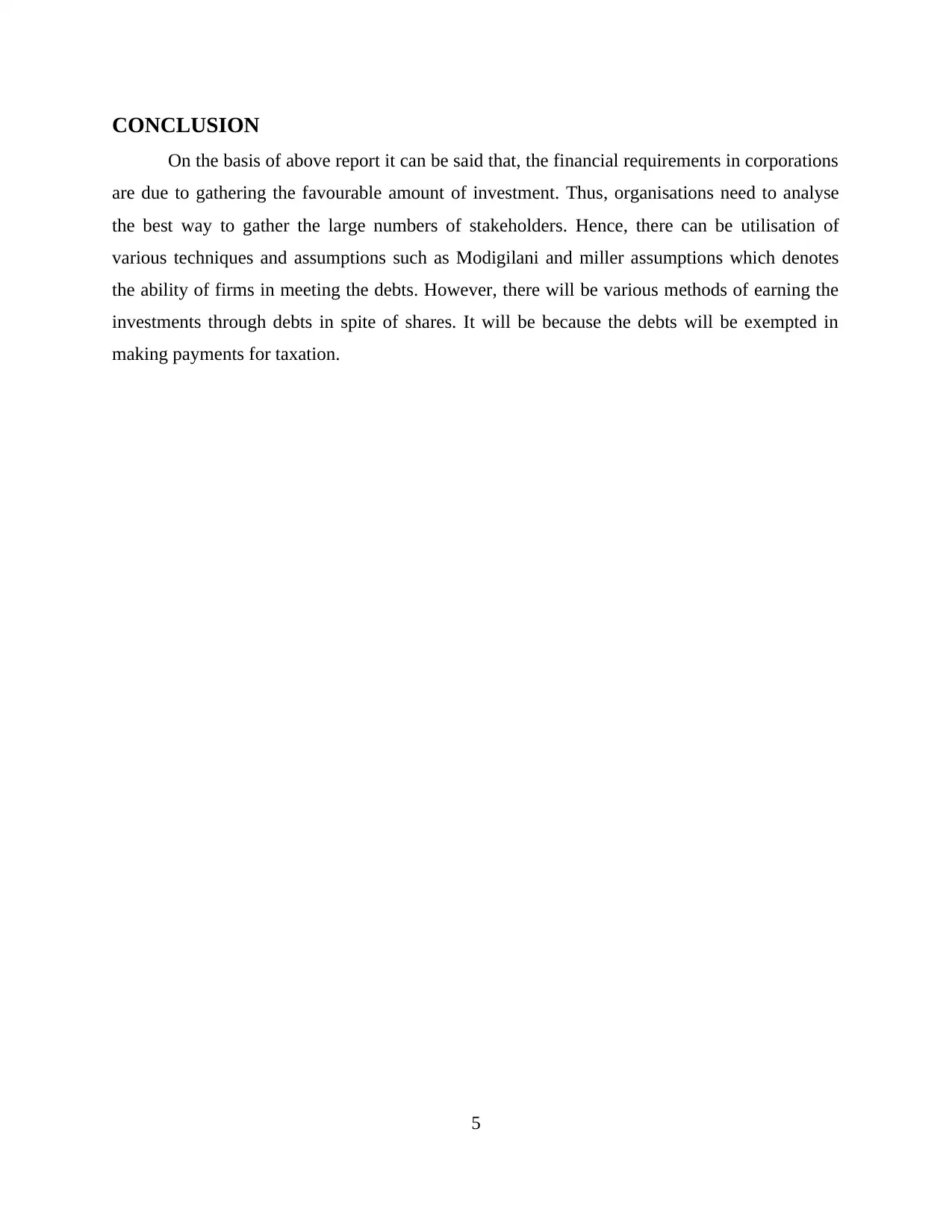
CONCLUSION
On the basis of above report it can be said that, the financial requirements in corporations
are due to gathering the favourable amount of investment. Thus, organisations need to analyse
the best way to gather the large numbers of stakeholders. Hence, there can be utilisation of
various techniques and assumptions such as Modigilani and miller assumptions which denotes
the ability of firms in meeting the debts. However, there will be various methods of earning the
investments through debts in spite of shares. It will be because the debts will be exempted in
making payments for taxation.
5
On the basis of above report it can be said that, the financial requirements in corporations
are due to gathering the favourable amount of investment. Thus, organisations need to analyse
the best way to gather the large numbers of stakeholders. Hence, there can be utilisation of
various techniques and assumptions such as Modigilani and miller assumptions which denotes
the ability of firms in meeting the debts. However, there will be various methods of earning the
investments through debts in spite of shares. It will be because the debts will be exempted in
making payments for taxation.
5
1 out of 7
Related Documents
Your All-in-One AI-Powered Toolkit for Academic Success.
+13062052269
info@desklib.com
Available 24*7 on WhatsApp / Email
![[object Object]](/_next/static/media/star-bottom.7253800d.svg)
Unlock your academic potential
Copyright © 2020–2025 A2Z Services. All Rights Reserved. Developed and managed by ZUCOL.





